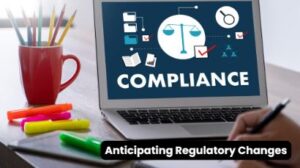Proactive Compliance: Effective Strategies to Stay Ahead of Regulations

Are you tired of the onslaught of new regulations affecting your business? With new laws and standards being made daily, keeping up with the reins of compliance seems like chasing a moving target. How do businesses manage to get ahead of the curve before they suffer financial costs or penalties through fines or reputational damage? The answer lies in proactive compliance.
Compliance is more than a reactive approach to change; it is taking the proactive approach of predicting, preparing for it, and embedding approaches that help your business stay in line with what’s current, tomorrow’s, or any other future regulations. Proactive compliance helps guide organizations through the labyrinthine regulatory landscape into long-term sustainability and security.
Understanding Proactive Compliance
Proactive compliance is about being forward-looking regarding regulatory requirements, from staying ahead of potential legal issues even before they arrive. Thus, it involves not just following regulations but also anticipating changes in laws and standards and being ready with one’s systems, processes, and teams for that end.
Forward thinking is the key in this fast-changing regulatory environment where laws change daily and grow increasingly complex. It is not a matter of waiting until something comes about as a violation of regulation, but proactive compliance will build the framework that ensures your business will always be ready.
Anticipating Regulatory Changes

Being informed is the first step in enforcing a proactive compliance approach. Regulations are constantly evolving, and it thus becomes very important that any stakeholder in such compliance solutions is always abreast of updates from the last few years and recently. This could be through government agencies, industry groups, or international standards.
Many businesses have compliance teams or outsource it to third-party experts who will track the updates of the latest versions of regulations. Technology also plays a big role. Automated compliance tools can help businesses track legislative changes.
In addition to finding the right external information, businesses also have to build an internally compliant culture. This means keeping all departments-working legal, IT, HR, or finance-informed on what is happening on the regulatory front.
Investing in Technology for Compliance Management
There is no understating of the role of technology in proactive compliance in today’s digital world. Indeed, even software meant to make compliance management relatively easy itself the possibility of automating many of the compliance tasks that otherwise would be time-consuming and prone to human error can allow for monitoring of regulatory changes, generating of compliance reports, and managing of audit trails.
Its process, automation streamlines compliance and reduces employee burden while minimizing the likelihood of human error. Real-time alerts enable compliance teams to catch issues before they become serious problems.
Another field where technology is increasingly being used is in predicting regulatory changes with the help of AI and ML. Using past trends to make an assessment, provides proof of how laws are likely to change. It means that organizations get warnings of future regulation changes, therefore, preparing and adapting as necessary before making any implementation action.
Training and Education for Employees

Another important component of an effective proactive compliance strategy is educating and training employees. This is not just the responsibility of legal and compliance teams, but rather that of everyone involved. Individual training helps the employee recognize why compliance is important and gives them knowledge of being compliant in their roles.
For example, the employees of any finance or human resource department will need a training session conducted in the departments to keep them abreast of the latest tax laws, labor legislation, or data protection requirements. Periodic refreshers and workshops will reinforce the importance of compliance at all levels.
Training should also identify the type of character the workplace is supposed to promote. The more that knowledge workers know why they should comply, such as helping to protect the company’s reputation and avoid litigation, the more apt they are to do what has to be done to stay in compliance.
Conducting Regular Audits and Assessments
Regular audits and assessments are necessary for maintaining proactive compliance. The consultations will provide an organization with a warning that when it is not doing things right; it can correct its mistakes before they become more severe. This opportunity, too, is the chance to review how effective current compliance practices are.
Internal audits are useful for organizations in identifying the possible weaknesses within their systems or procedures that may eventually result in their non-compliance. For example, protecting more data or refreshing some of the departments’ training on newer laws and regulations in order to keep up with the changing legal scenarios may be required.
Audits can also serve to benchmark a firm’s own approach against the industry or competition. This will ensure that its compliance efforts are up to the best in class and that it does not inadvertently lag.
Fostering a Strong Relationship with Regulators
One often overlooked aspect of proactive compliance is building a relationship with regulators. Compliance officers and legal teams tend to focus primarily on complying strictly, but sometimes it can also be helpful to talk to the bodies that create and enforce those regulations.
Good communication with regulators will make a company better understand the priorities that lie ahead and clarity on the tougher regulations. These days, some industries offer advisory services to business entities so that they might pose questions or seek light on a matter.
This can prove to be of great use if the business is involved in a compliance breach. In case the business entity has a record of being open and working well with the regulatory bodies, it can find that such regulators are tolerable and willing to work out issues with them before they become bad proportions.
Documenting Compliance Efforts
| Aspect | Details |
| Importance of Documentation | Documentation is key in proactive compliance, showcasing that a business is prepared and ahead of regulatory changes. |
| Role of Records | Records such as audits, training programs, and communications with regulators help businesses maintain an organized and accessible compliance history. |
| Ease of Verification | Well-organized documentation makes it easier for businesses to verify compliance steps during audits or inspections, ensuring transparency and readiness. |
| Tracking Progress | Documentation allows businesses to track compliance over time, identifying whether or not improvements are being made. |
Conclusion
Proactive compliance in developing the company should be ahead of regulatory changes to avoid costly fines and stay long-term successful. Anticipation, use of technology, educating employees, conducting regular assessments, building relationships with regulators, and keeping detailed records will achieve such proactive compliance; hence, a risk-proof and maximal operating culture will be developed.
FAQs
- What is proactive compliance?
Proactive compliance is the strategy of anticipating and preparing for regulatory changes before they occur, rather than just reacting to them. It involves staying informed, using technology, and integrating compliance into everyday business operations.
- Why is proactive compliance important?
Proactive compliance helps businesses avoid costly fines, penalties, and reputational damage by ensuring they are always prepared for changes in regulations. It also supports long-term sustainability and security.
- How can technology aid in proactive compliance?
Technology, such as compliance management software and AI tools, automates tracking regulatory changes, sends real-time alerts, and helps businesses stay ahead by predicting future regulatory trends.
